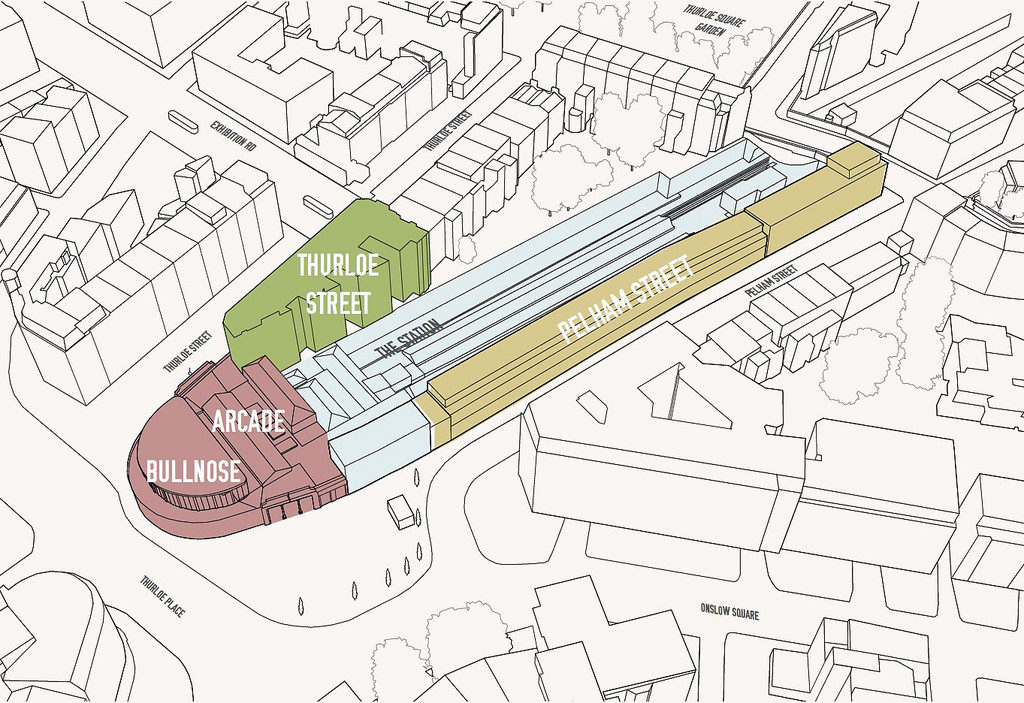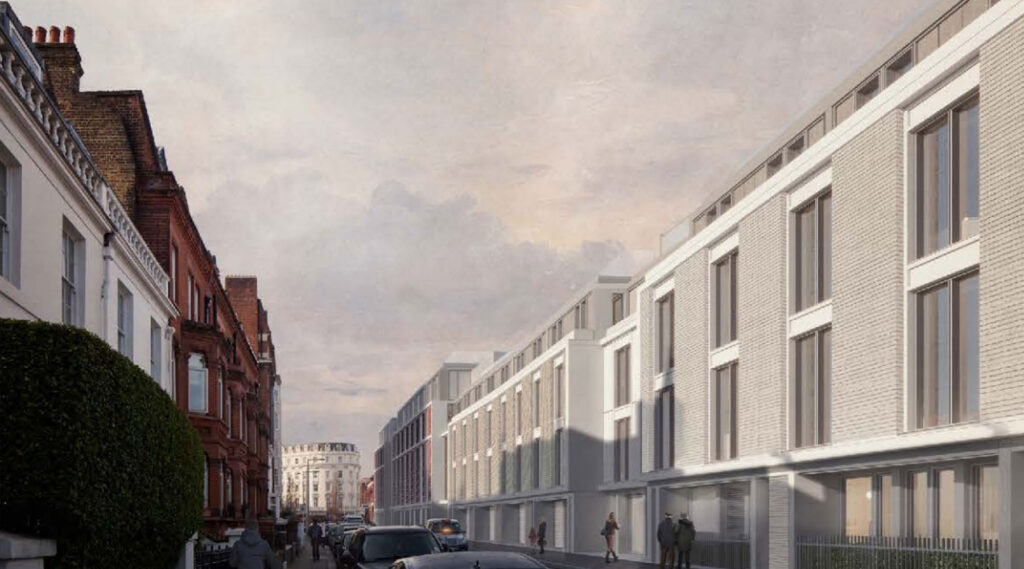Last night, after a marathon 3.5-hour debate, Kensington and Chelsea council decided to block planned oversite development around South Kensington tube station.
The plans would have seen the row of Victorian shops and flats rebuilt behind the retained facade, the bullnose in front of the station rebuilt with additional floors, and on the south side where the station is an open cutting, a row of flats built.

Image from previous plans – showing the relationship of the areas affected.
In the planning session, which was noted by the Chair as the busiest they have had in several years, it was clear where the public gallery observers preferences lay. The objectors put forward their objections, with each speaker applauded after they finished, and the developers put forward their views, with silence from the public gallery.
Although only a small, if very important part of the development, the plans to provide step-free access from the street to the Circle/District lines absorbed a lot of the debate.
The developers didn’t do themselves any favours in the evening by not providing a clear simple explanation though, that the lift gave step-free access from the street to both the ticket hall and the subway leading to the museums, and that step-free access to the Natural History Museum and V&A will be possible, with the Science Museum maybe later. A lack of clarity about the existing plans to add step-free access to the Piccadilly line later also didn’t help the cause.
A commitment was offered on the night to alter the legal agreement so that step-free access to the ticket hall and subway would be offered upfront, but that was clearly not enough to sway the planning committee.
This was because, although a lot of the debate on the evening was about the step-free access, the decision was largely based on the visual impact of the buildings, and in particular the bullnose in front of the station.
The developers argue that without the bullnose development, then the economics would render the project unviable, and were pressed to confirm that they wouldn’t come back later with a bullnose-light project having found a way of funding the rest of the development.
The planning officer report before the meeting recommended that the development should go ahead as the benefits were greater than the “less than significant harm” caused by the development. This resulted in a lengthy debate about the meaning of less than significant harm in a heritage context, and whether the view from one side of the bullnose of frankly, another row of houses on the other side, being impaired by the bullnose development was a heritage issue.

(c) Rogers Stirk Harbour + Partners / Native Land
The building planned to sit at the far back corner of the station was also a matter of some concern, with objections to its size and modern design sitting on a corner with a mix of Edwardian and Victorian buildings.
A controversy occurred though, when the objectors submitted, just one day before the planning meeting, a series of amended views of the buildings, which later turned out to have possibly been based on older plans, and a debate about the use of wide-angle and narrow-angle camera lenses for the design mock-ups took up a fair bit of time.
Following representations by objectors and the developers, and then a session of questions to the councils’ own planning officer, the vote was taken and was swiftly unanimous in refusing planning permission.
A spokesperson for the Native Land and TfL joint venture has said: “We believe our plans, which are policy compliant and were recommended for approval by RBKC’s planning officer, who cited architecture of the highest quality, provide for a considered scheme that would help bring a renewed sense of place to South Kensington. We will now review our options.”
The Chair of Kensington and Chelsea’s Planning Committee, Cllr James Husband, said: “We have given this application detailed consideration and rejected the scheme based on significant concerns about the impact of the architectural design, height and massing of the proposals on the Conservation area and listed buildings. Councillors agreed that step-free access to the Circle and District lines would be a benefit, but does not, on balance, outweigh the harm done by the design.”
This is the latest in a long line of attempts to revamp the land around the tube station and renovate the station itself. While the plans for the station refurbishment are already approved, the step-free access to the street was always going to be dependent to some degree on the property development, not just for funding, but mainly so they could leave a hole in the new buildings to provide the lift shaft.
Over the years, plans have been architect-led and always faced strong local opposition. About half the people objecting last night seemed to be generally against any change, while half accepted change was needed, and maybe even desirable, but not the changes being proposed.
Going forward, they may have to open up a public competition where anyone can submit top-level concepts for a general scheme, that could then be short-listed and refined into options to be put to the local community. Set some basic minimum criteria, to take into account the economic and engineering constraints, and see if local residents are able to come up with something that meets those requirements, while also being popular enough to push ahead with.
The architects suggested a range of decent quality if frankly slightly unchallenging modern architecture, but if building a row of fake Victorian frontages is what it’s going to take to get planning approval, then maybe that’s what’s should be built.

(c) Rogers Stirk Harbour + Partners / Native Land
This morning, the council suggested that it may be able to assist in funding the step-free access at the station.
The council’s Lead Member for Environment, Planning and Place, Cllr Johnny Thalassites, who does not sit on the planning committee has said that knowing how expensive adding step-free to the station without supportive funding from the development would be, that he is “looking at our Council budget to see if we can offer a financial contribution to Transport for London to make step-free access a reality.”
That could mean the station finally gets the step-free access it’s long needed.
(amended after publishing to add comments from the council)







RBKC and the local residents being NIMBYs once again. Stagnating progress, and critically preventing modernisation and step free access. Shameful.
RBKC wisely rejected the destruction of a historic and charming part of London to the “profit above all” developers.
Step free access to SKen can still be achieved as a separate project.
Back to the drawing board AGAIN. I honestly thought the latest revisions would be approved.
The developer could appeal – depending on the actual planning grounds the council gives for approval.
That new bullnose development looks incredibly out of character for the area, I’m not surprised that there were strenuous objections.
That included me. I attended the presentation at Imperial Coll back in 2019, pre-pandemic. The architects were incredibly arrogant and hostile. Had no regard for blending with the architectural grace of the area. One stormed off in the middle of the meeting.
Maybe the developer and their consultant team need to do a series of design workshops to resolve the design issue. Its not goog to have the locals in opposition, particularly in South Ken.
Residents actually discussed and agreed a set of conservation led development proposals for South Ken with TfL in 2018 – proposals which delivered development on site and step free for BOTH London Underground lines. Then TfL’s private sector partner came on board and junked the lot while claiming their entirely different proposals reflected ‘the spirit’ of what had previously been agreed….and there was silence on step free to the Piccadilly line ….
And back to the drawing board and I actually thought this revised scheme was a decent proposal. The station will remain a dump for some time yet I guess. No doubt a case of be careful what you wish for.
The eclectic mix of oddball businesses along the Northern flank would probably vanish. The quirky Medici card shop is legendary. My wife would be devastated.
Growing up in the1950s that area was a village.
That was 70 years ago though, international tourism hardly existed and half of central London was still in ruins.
Hoorah for the cancellation of these horrible plans. Step-free access to all Tube stations eventually is most desirable, but why must historic buildings be demolished wholesale, and hideous, overpowering new structures be built to ruin what is still a charming and pedestrian-friendly neighbourhood? Also, small shops are disappearing, and we need them!
Beatrice, I agree with you — if we are just to make London one huge new development, why not turn it all into a Theme Park? Oh, oops — no more tourism for the foreseeable future, due to the pandemic (which shows no signs of disappearing) — maybe London the Car Park, instead?
We definitely support the Committee’s decision.
It’s this unfortunate attitude that means nothing ever changes.
The Resident Associations have always fought for SFA and were and will be supportive to a development that is heritage led and that preserves the character. Somewhere above it mentioned the Development Brief that TfL and RAs put and agreed. NL came on board and it was entirely off the table.
Separately TfL’s much more needed below ground Station Capacity upgrade, a separate project from this, was approved with the support of the Resident Association in Jan 2019 with TfL that works would start in 2019. nothing happened. So blaming the RAs is far from the truth.
You say the RAs are supportive of a heritage-led development, but which heritage? The area around the station is a mix of everything from Victorian to 1980s, so why is there pressure to have a 19th-century design and not the 20th century design, or horrors, maybe 21st-century design?
The area around South Kensington tube station has never been stuck in the past, so why does it need to be now?
Heritage led as agreed by RAs with TfL did not mean or require a pastiche of old styles and it didn’t oppose modern architecture – it meant not destroying but restoring existing valuable fabric, respecting existing height levels (so eg yes to increasing the height of the Bullnose but no to 5 floors that overshadow and dwarf the listed arcade) and maintaining the low rise village feel of the area and the much-valued small shops. What we were offered could have been built anywhere and trampled upon and destroyed everything that makes Sth Ken unique and attractive…